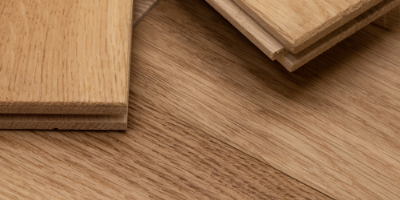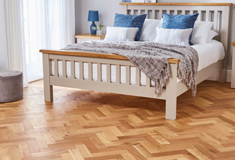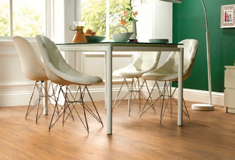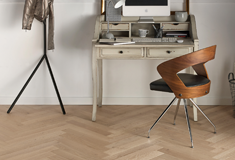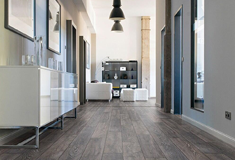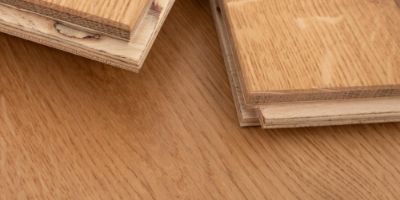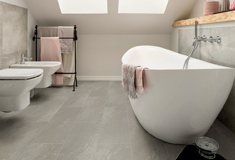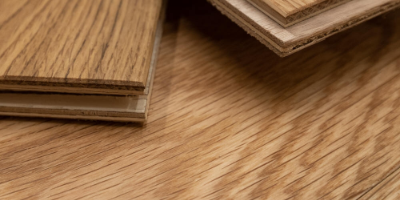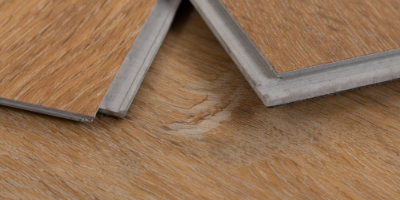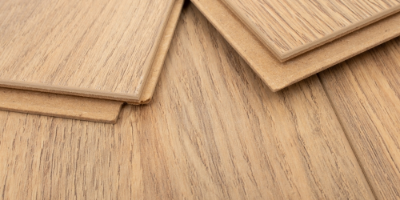Home Office Flooring: What’s the Best Choice?
With more businesses offering hybrid roles and remote work than ever, having a home office is quickly becoming an essential in every modern home.
If you’re setting up your own work-from-home space, you’ve probably got the basics covered. Desk? Check. Laptop? Check. Assortment of knick-knacks taking up half your desktop? Check. But what about the flooring you’ll need?
The right flooring option for your home office will depend on the nature of your work, whether you have clients visiting you at home and, of course, your personal style. Read on to find out which are the best floors for a home office.
Solid Wood Flooring
Pros
- Luxurious, high-quality appearance
- Natural aesthetic
- Long lifespan
Cons
- More expensive
- Higher risk of stains
- Can’t be used with underfloor heating
Solid wood flooring is arguably one of the most beautiful types of flooring on the market. Featuring swirls, knots and grains found in real oak, acacia and walnut, a solid wood floor will give your home office an air of classic luxury.
However, it also requires regular cleaning and needs to be refinished and sanded every now and then too, so it’s worth noting it isn’t a low-maintenance option.
Another point to consider is that installing solid wood can be a lengthy process, so your workspace might be out of action for longer, compared to other types of home office flooring.
Engineered Wood Flooring
Pros
- Has the appearance of solid wood
- Resistant to fluctuating temperatures
- Safe to use with underfloor heating
Cons
- Shorter lifespan than solid wood
- Only allows sanding and refinishing a limited number of times
- Being a natural product, it’s more likely to stain
Engineered wood flooring is the perfect choice if you want the beauty of solid wood without the price tag.
This flooring surface is made by sticking layers of plywood together to create a ‘plank’. This block of wood is then topped with a real wood veneer, to imitate the finish of real wood.
Another benefit of engineered wood is that, unlike solid wood, it doesn’t warp when the room temperature changes. This makes it perfect if you want to treat yourself to underfloor heating to keep your office cosy.
Engineered wood can be sanded and refinished, just like real wood. However, you may only be able to do this five or six times, depending on the thickness of the flooring you choose for your home office.
Luxury Vinyl Tiles (LVT)
Pros:
- Costs less than wood flooring
- Spill-proof and stain-resistant
- Extremely durable
Cons:
- Doesn’t have the same longevity as real wood
- Can’t be refinished when it shows signs of wear
Luxury Vinyl Tiles (LVTs) are a great option if you want the appearance of a wood or stone floor, but your budget won’t stretch to cover the real thing.
Vinyl tiles are made from a rigid core that ensures they’re strong and sturdy. The top layer is finished with a textured surface that mimics the effect of real wood or slate.
Another benefit to choosing a vinyl floor for your home office is that it’s completely spill-proof and easy to clean - perfect if you’re worried about spilt drinks, or mucky shoes traipsing over your floor!
LVTs are one of the most durable floors on the market, however, you can’t sand and refinish them as you can with real wood. This means your flooring will have a shorter lifespan if you choose vinyl over wood.
Laminate Flooring
Pros:
- More cost-effective than wood
- Extremely water-resistant
- Quick and easy to fit and maintain
Cons:
- Not as long-lasting
- Can't be refinished like real wood
Laminate flooring is another great alternative to wood and is available in a range of oak effect designs. It’s extremely budget-friendly so you can get the look of real wood for a fraction of the price.
Laminate is made from HDF (high density fibreboard) and is topped with a photographic layer depicting a natural element such as wood or stone. This top layer is coated with a transparent finish that protects the floor from scratches, spills and stains.
Laminates are extremely hard-wearing and much more cost-effective to buy than wood. However, like LVTs, they can’t be sanded and refinished when they start looking a little worse for wear. This means your floor is likely to need replacing sooner if you choose laminate flooring over wood.
Get Social
Need a little help choosing flooring for your home office? Get in touch today, our friendly flooring experts are always on hand to assist.
Follow us on Instagram for all the latest news, blog posts and handy tips and tricks. And don’t forget to share your home office flooring and tag #MyLuxuryFloor. We can’t wait to see your gorgeous new floor in action!

